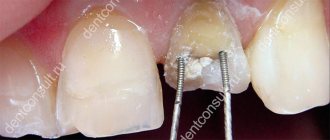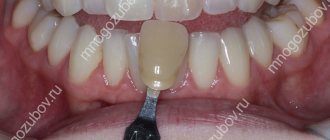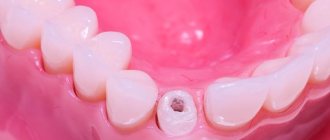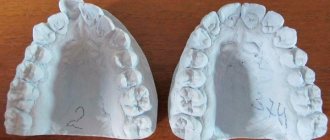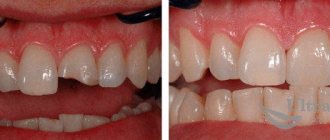1639
The safety and well-being of the patient during and after dental procedures force each clinic to introduce the latest technologies and modern materials into the work of doctors.
Of the latest developments in strengthening and restoring teeth, most dentists prefer the GlassSpan system.
What is "Glasspan"
GlasSpan (“Glasspan”) is a flexible tape based on ceramics and composite, which serves to unite teeth, that is, direct splinting. Produced by the company of the same name GlasSpan. The tape is compatible with all dental materials, resistant to moisture, and has no taste or odor. In addition, the width of various modifications of the tape does not exceed 3 mm, which allows it to remain invisible in the oral cavity, but at the same time perform its function properly.
Interesting! This product is produced in glass capsules in several versions: in the form of a tape (width no more than 2 mm), in the form of a small cord (width 1 mm), medium (width 1.5 mm) or long (width 2 mm). The length of all products of the Glasspan system is 27 cm. But, logically, it is cut into pieces - in accordance with how much a particular patient requires.
Purpose
One of the methods used to correct dental defects or perform implantation. In reality it is a flexible ceramic bond for restoration. The method has become widespread due to its compatibility with almost all materials.
Effective for temporary, adhesive, intermediate bridges, and also quickly strengthens loose teeth. Does not cause side effects. Compares favorably to reconstruction using a crown or pin. The method is used if necessary:
- Replacement of missing unit.
- Making a durable bridge.
- Stabilization of damage.
Indications for the use of Glasspan
Splinting with glasspan tape is prescribed in various clinical situations, which makes this material almost irreplaceable in orthodontic and prosthetic dentistry. Most often, this tape is used to solve the following situations:
- emergency restoration of dentition and chewing function in case of loss of anterior incisors and canines (for example, as a result of injury),
- temporary strengthening of bridges if they have become loose,
- replantation, that is, the return of a tooth removed (due to injury or complex surgical treatment) to its own alveolus,
- tooth restoration using an intracanal pin,
- fan-shaped divergence of the upper front teeth,
- achieving retention (holding teeth in a new position) after orthodontic treatment.
The tape is fixed on the inside of the teeth, unites them into a group, thereby helping to strengthen their position. In addition, due to the strength of the material, composite materials can be strung onto the tape, which allows this option to be used for prosthetics. But, of course, temporary, because such an adhesive prosthesis will not withstand heavy loads.
Reviews
Every year, new materials and techniques appear in dental centers that allow you to quickly restore or restore the required number of teeth. Of all the latest developments, the GlassSpan system has become the most popular.
You can share your experience in dental treatment/restoration using this technology and express your opinion regarding its quality and effectiveness by leaving a comment on this article.
If you find an error, please select a piece of text and press Ctrl+Enter.
Tags splinting
Did you like the article? stay tuned
Previous article
ProRoot MTA - reliable protection and restoration of root canals without the risk of rejection
Next article
Rules for working with the unique composite material Herculite
Advantages of this splinting system
- "Glasspan" retains its fastening properties even at high temperatures and high humidity, that is, you can drink hot drinks without obvious restrictions,
- has a long service life,
- does not cause shrinkage, thinning, abrasion and other deformations,
- There are no fringes, tears or other damage to the integrity of the product at the cutting site, so dentists note that this system is very simple and easy to work with,
- has high aesthetic characteristics (the tape is invisible in the mouth because it has a light shade),
- does not cause discomfort when wearing,
- easy to use (that is, the doctor does not need to use additional tools when applying a splint).
Analogs and price
The price of the GlasSpan set is approximately 1200-2100 rubles. The cost of reinforcing one dental unit using products starts from 1,300 rubles.
The price is indicated approximately, because each clinic has its own price list, and can adjust it depending on the complexity of a particular case.
Here are approximate prices for products similar in purpose:
- Ribbon (tape for strengthening various dental structures) – 7,300 rubles;
- Bioloren InFibra (splinting tape) – from 2800 rubles;
- Fiber-Splint (tape for restoration of teeth and splinting) – 2100 rubles;
- Fiber-Splint ML (multilayer tape for splinting) – 4,500 rubles.
Thus, GlasSpan not only surpasses similar products in terms of material quality, but also has a more attractive price and greater durability.
The video shows a diagram of splinting teeth with fiberglass material.
Disadvantages of this splinting system
- applying a fiberglass splint requires high manual skills from the doctor, otherwise the splint will cause discomfort to the patient, since its edges or fibers can stick out from the filling material and thereby injure tissues and make it difficult to clean teeth,
- since the tape partially covers the dental spaces, oral care becomes more difficult and the risk of caries in these hard-to-reach places increases,
- splinting with Glasspan for periodontitis and periodontal disease can act as a temporary measure (or for a mild form of the disease), since the tape leaves the teeth some mobility and lasts less (up to three years) than, for example, an aramid thread (up to six years) for cable-stayed splinting.
In general, the patient needs to understand that no matter how the doctor fixes the moving teeth, the therapeutic effect will still be temporary. In particular, if the gums are not treated, the teeth will still become loose and will fall out in the future along with the installed band.
Patient reviews about dental splinting
Photos before and after splinting teeth show that the results of this procedure are indeed quite impressive. Reviews about splinting teeth are also very good - people note that this procedure helps them save teeth that, without this procedure, are only suitable for removal. Most often, a splint is placed during treatment of periodontal disease or periodontitis, but sometimes it is installed to consolidate the result of treatment with braces. Patients only note that it becomes a little more difficult to clean the interdental spaces, but in general they do not experience any discomfort or pain.
Tactics for using fiberglass tape
First method: splinting
The most common method designed to combine the front and side teeth into a single block. It is used for periodontitis, periodontal disease and after wearing braces/aligners to secure the position of teeth. The tape is installed on the inside of the teeth (less often, on the front, but in this case it will be very noticeable, so it’s better not to use this option).
Second method: microprosthetics
Using this tape, an adhesive bridge is created: the use of glasspan tape as a reinforcing material for prosthetics of one unit (most often frontal). The essence of the method is that a fiberglass tape is glued to the teeth adjacent to the missing teeth using a composite material, which is “stretched” over the toothless area. After this, the tape is strengthened with a special polymerizing lamp. Next, an artificial tooth is glued onto this frame, i.e. crown. This method is suitable for patients who suffer from allergies to various metals, or when it is necessary to quickly restore a lost tooth. It, of course, will not withstand a heavy load, but if we are talking about urgency, then this option is quite possible.
Tactics of use
The technique of using products is directly determined by the type of influence required in a particular clinical case.
As already mentioned, the properties of the product allow it to be used for any cases where restoration or strengthening of teeth is necessary. Below are instructions for each of them.
Splinting
The method of performing splinting is different and depends on the location of the problem group of teeth.
For example, if the front teeth on the lower jaw are strengthened , then, first of all, a small groove is formed on the lingual side of the teeth in which the cord is placed.
The splinting material should cover not only the problem group of teeth, but also adjacent healthy units in order to evenly distribute the physiological load during the chewing process.
After this, the groove is filled with a composite composition. As a result, the mobile teeth are firmly grasped by the ceramic system and become more stable.
If splinting is performed on the upper front teeth , then a GlasSpan groove is made on the outside of the teeth.
If the lateral and posterior chewing teeth are splinted , then the groove should be drawn only along the chewing surface of the teeth. Otherwise the technology is similar to the first example.
Microprosthetics
The use of products during microprosthetics is indicated for those patients who are allergic to metal elements of prosthetic structures.
The technology consists of replacing a fragment of a missing tooth using fiberglass reinforcement. It should be noted that this method is only relevant for the treatment of frontal dental units.
Manufacturing of adhesive bridges
An adhesive bridge is a structure used to replace teeth that have lost functionality.
This design is installed without grinding adjacent teeth, using pins resting on adjacent healthy teeth.
When making and strengthening adhesive bridges, GlasSpan tape is used to lay fiberglass pins, which create the basis for the future prosthesis.
This method is also relevant for patients who are allergic to structures made of metal alloys.
The main causes of darkening of tooth enamel and ways to eliminate the defect.
In this publication we will talk about the symptoms and treatment of a tooth root fracture under the crown.
Follow the link https://zubovv.ru/lechenie/zubyi/funktsii-septopaka-v-stomatologii.html to get closer to the features of using the Septopak material in dentistry for temporary filling of teeth.
How is splinting done with tape?
To strengthen the incisors, a small groove is made on their inner side, where a glasspan cord is placed, after which the entire structure is covered with composite material. Also, the tape can be fixed simply from above, without recesses. In this case, the ends of the Glasspan must be attached to stable units so that a strong reinforcement structure can be created. Installation of the tire can be carried out without drilling a groove, simply securing the tongue of the tape with a light-curing composite.
On the lateral teeth and molars, splints are applied along the chewing surface of the crowns using the same technology.
Important! Since the ceramic material of glasspan tapes and cords is heat-resistant, they are not afraid of final grinding and polishing. Unlike tapes based on plastic compounds, which can melt and become deformed, ceramics remain stable.
Benefits of installing a tire
Splinting, firmly fixing the teeth, returns the patient the ability to chew solid food without fear of permanently moving the tooth root and losing the tooth.
In addition to saving chewing function
, splinting can
restore a beautiful, open smile
. The main thing is to have time to remove the problem in time, because due to daily chewing load the condition can quickly worsen.
The technique has a lot of advantages
. Firstly, it is its simplicity and the ability to perform it in one procedure. Splinting does not harm the tooth structure and does not interfere with daily hygiene. The tires used are strong and durable, and can be quickly removed if necessary.
Specifications
“Glasspan” has gained popularity among dentists primarily because of its characteristics, which significantly improve the quality of work and facilitate the installation process itself. Many doctors choose this material for the following reasons:
- These products are smoother, which means they are less susceptible to contamination. They do not have a porous structure, so plaque does not accumulate or settle,
- Many splinting materials must first be impregnated or treated with various solutions to increase their adhesion. “Glasspan” is immediately ready for use, so the doctor avoids unnecessary contact with the impregnating substance, which stains the gloves and thereby makes it difficult to work in the oral cavity,
- the flexibility of glasspan tapes and cords allows them to be bent at any angle, which means that teeth can be splinted in almost any clinical situation, which can sometimes be quite unique,
- the unique structure of the product eliminates the formation of fringe and shedding during incision, which means it is safe for the patient,
- the cord has the structure of a hollow rope, that is, it can be filled with any composite material, which makes it universal in terms of use: “Glasspan” is used for bridging internal tooth cavities, reinforcing prostheses, including bridges,
- Since glasspan products have a woven structure, they can be unfibered to perform various manipulations, including those of a restoration nature.
Working and technical qualities of the material
Most dentists who use Glas Span in their work stated that this material, compared to other fiber reinforcement systems, is easier to use because does not get dirty.
Some of the other reinforcement materials are treated or pre-impregnated with resin and cannot be touched directly by fingers or gloves without contamination. This makes it difficult to handle or attempt to place the splint in the mouth.
GlassSpan tape is the thinnest and most flexible material for splinting. Other reinforcing materials are much thicker.
The tape can be cut with any seam or cord scissors. Materials from other manufacturers require special scissors, which must be purchased at an additional cost.
Unique round braided rope configuration: This is the only fiber that is twisted into a hollow rope (in addition to tape), it is more suitable for intracoronal splinting, as well as for bridge reinforcement, post and core extensions. The ropes can be inflated with flowable composite or layered material.
Patented Surface Treatment: Glas Span is the only etched and silanized ceramic fiber that provides ultimate mechanical and chemical adhesion to composite resin. Some of the other fibers are pre-coated with resin, but without the proprietary surface treatment that provides maximum bond strength.
The tapes are made of ceramic fiber, not plastic - ceramic fibers are more dimensionally stable than plastic, do not absorb moisture, and do not require restoration. The transparency of fiberglass is more aesthetically pleasing, and the ceramic material does not wear out. If it is exposed during polishing, it can be easily closed without endangering the entire restoration. This does not apply to plastic reinforcement materials.
If the plastic fibers are accidentally exposed to heat during polishing and adjustment of the restoration, they will begin to fuse. The material becomes contaminated, which means the entire tire will have to be remade. At the same time, GlasSpan can be easily polished; the material does not react to temperature changes.

